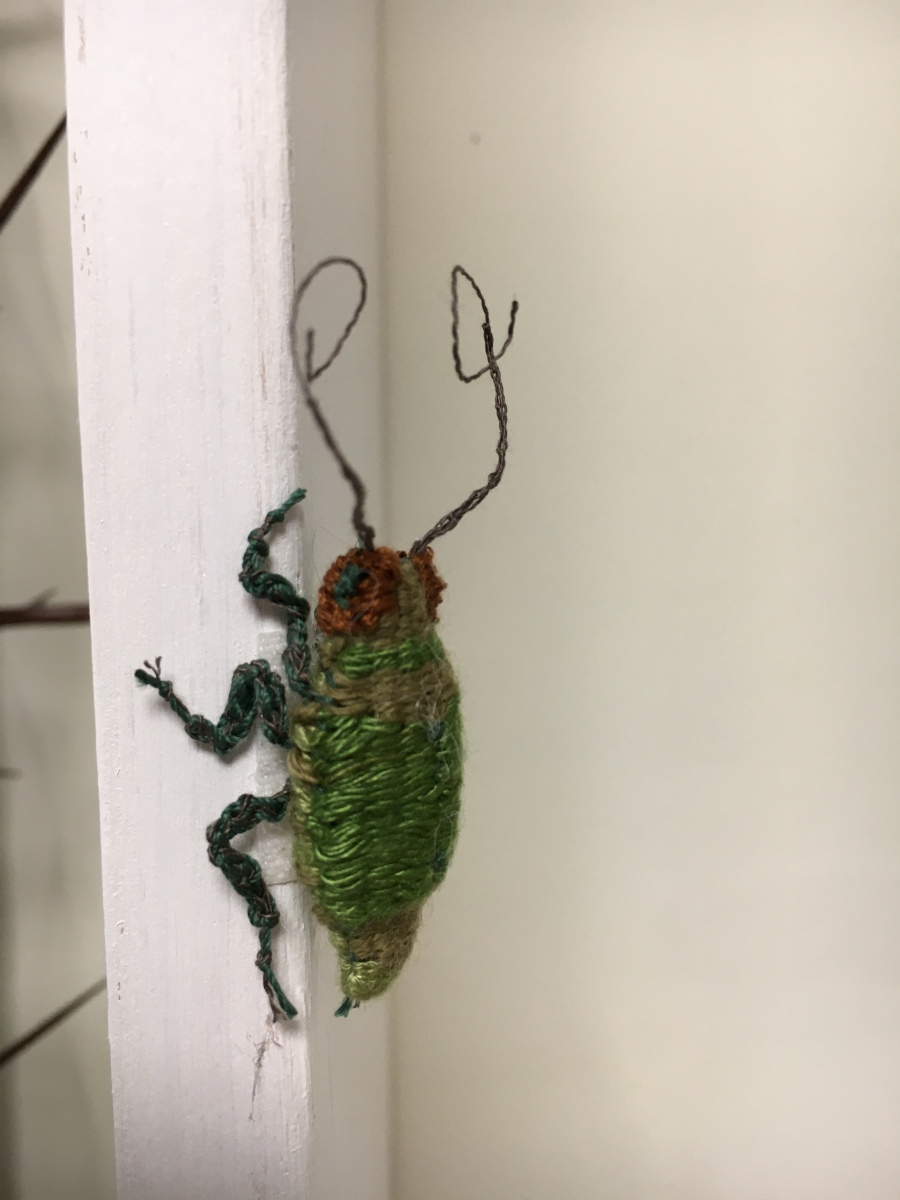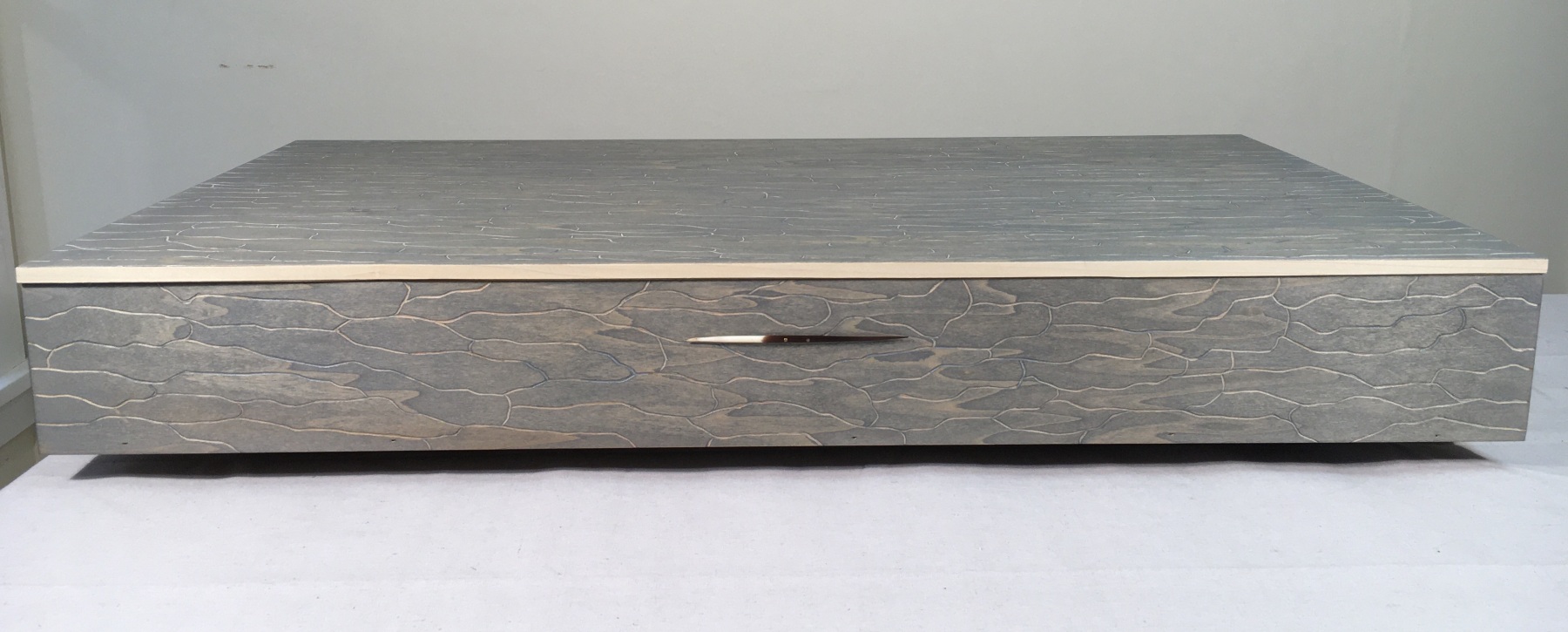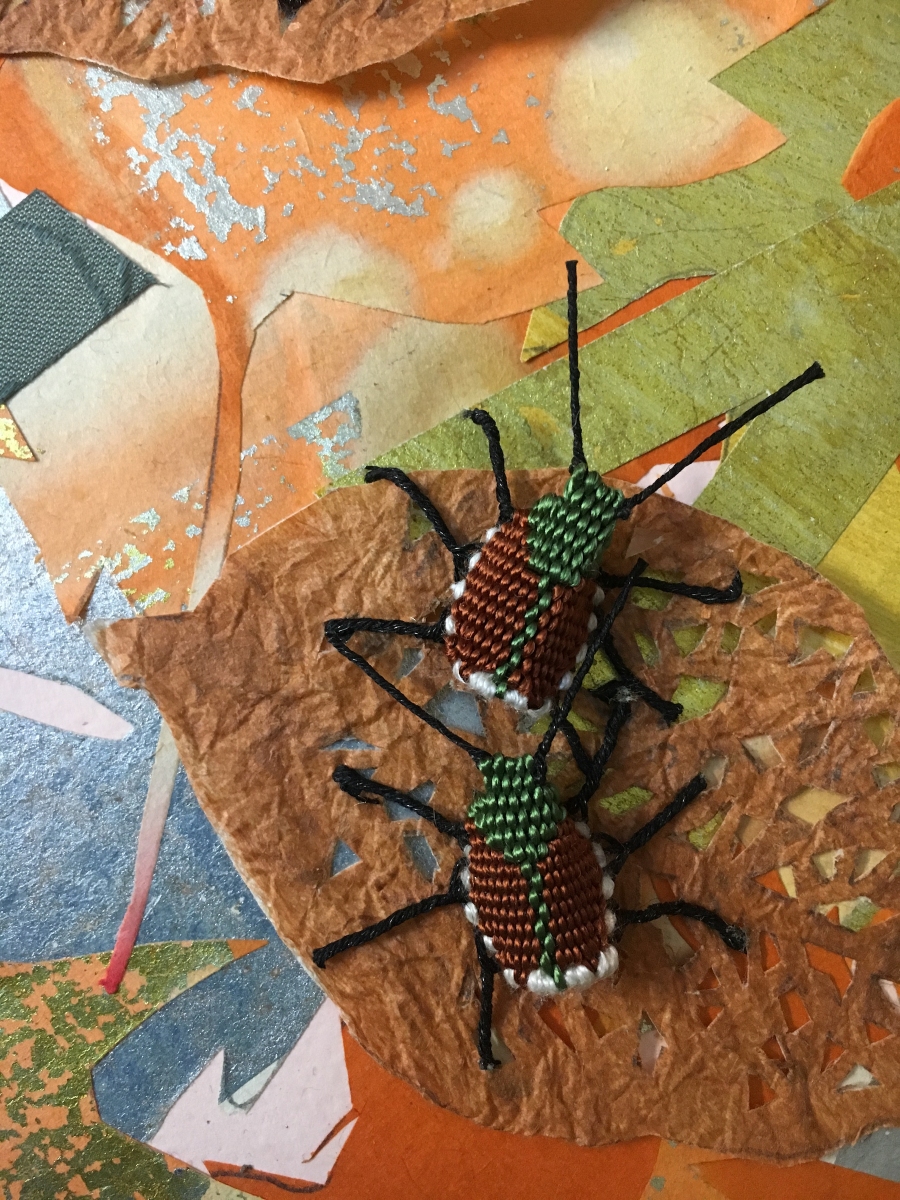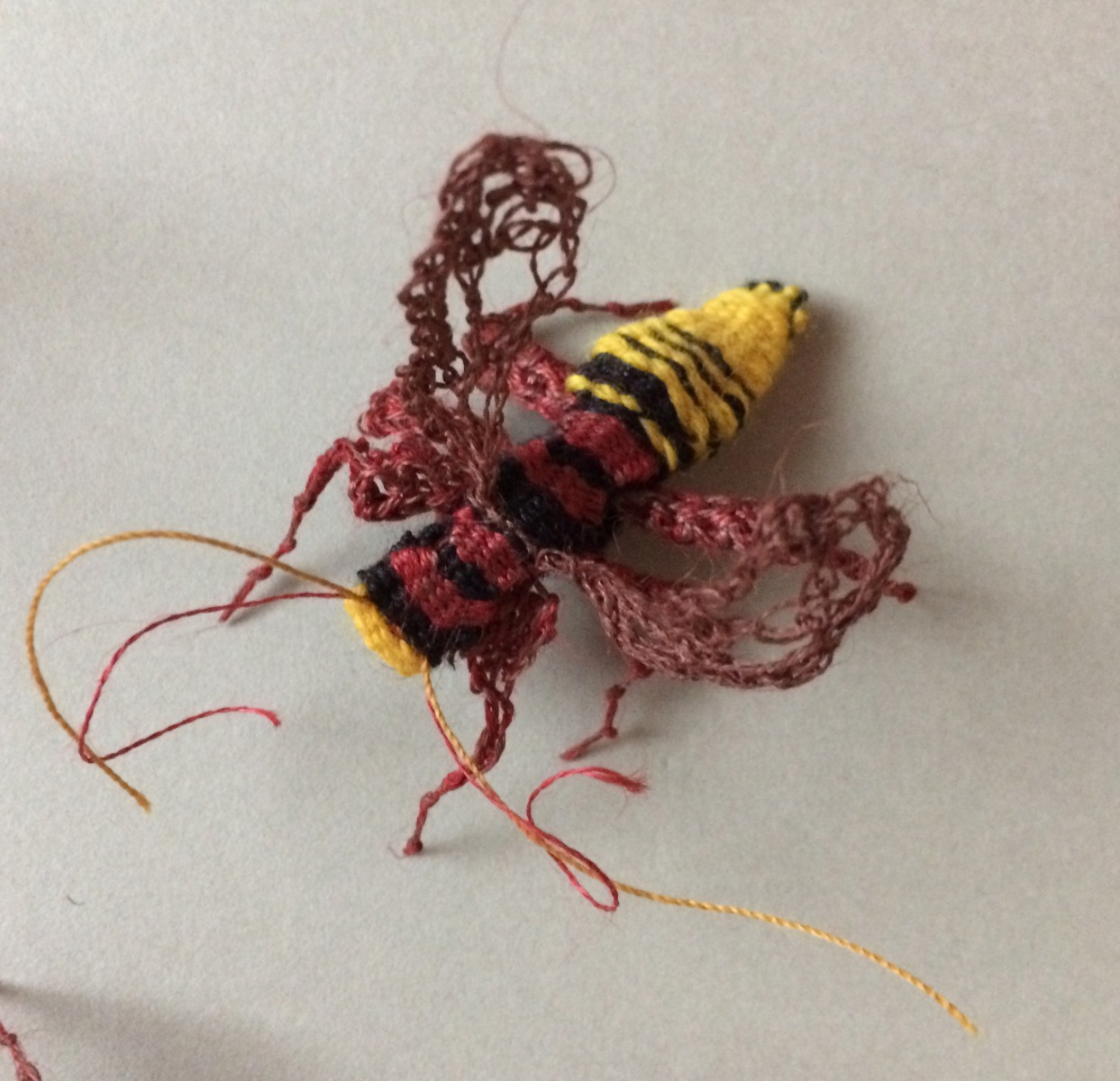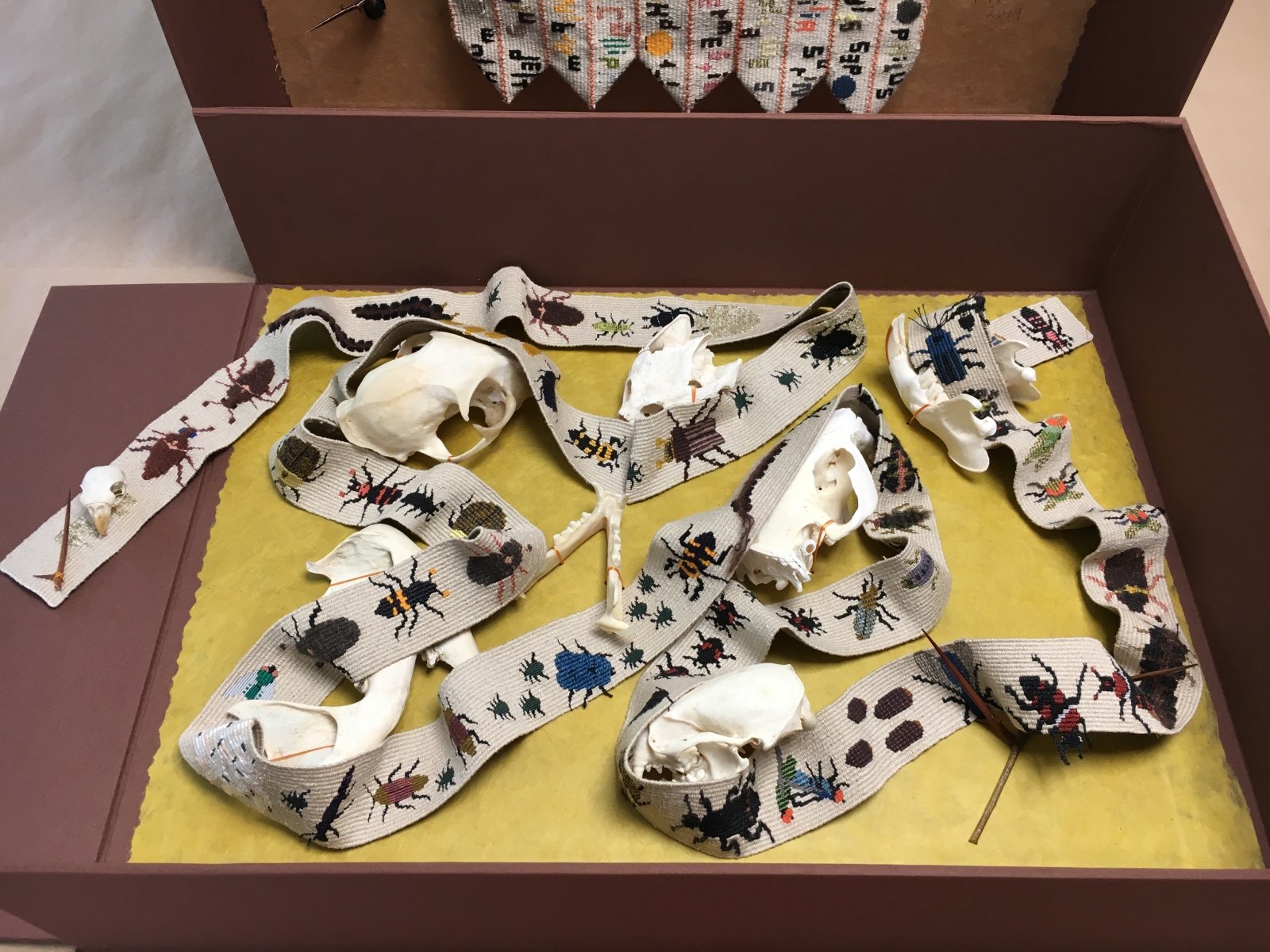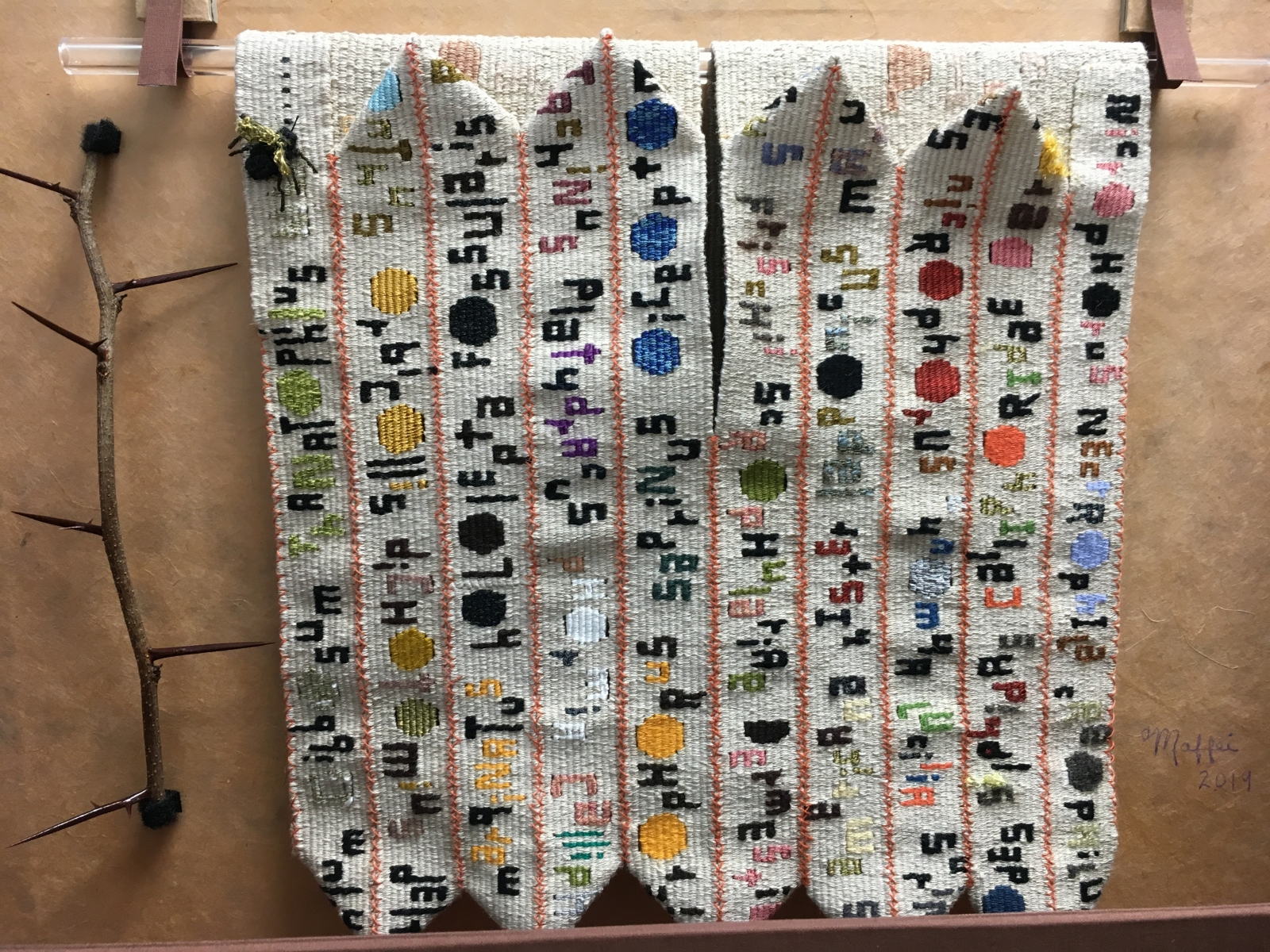The Pandora Box Series looks at invasive, threatened, declining and interesting species of animals both large and small. See more details of these pieces on Susan’s Instagram page.
“Pandora Box – Black Walnut Tree”
Black Walnut trees (Juglans Nigra) are native to eastern North America. Two native insects of interest that inhabit and influence these trees in some way are the walnut twig beetle and the lace bug. The Walnut Twig Beetle (Pityophthorus juglandis) is responsible for the spread of a deadly fungal disease to Walnut and Black Walnut trees. This tiny insect is about the size of a third a grain of rice. The beetle itself does little damage to the trees but when coupled with a hitchhiking fungus “Geosmithia morbida,” it causes what is known as thousand cankers disease. When infected, the health of the tree declines and within a few years can cause death. Although native to a just few states in western U.S. they have now invaded the Northeast.
The Walnut lace bugs (Corythucha juglandis) are tiny insects that range from 1/8” to 1/3” long. They feed on the underside of leaves and can discolor the leaves but do not normally affect health. They are distinguished by the unusual doily-like lace appearance of wings and thorax.


30” x 25” folded, Linen warp, wool and linen weft, rami & linen knotted net, found walnut shells, cotton lining, plexiglass support pedestal.
Click on images to enlarge slide show.
Black Walnut Shells
Walnut lace bug: body 1.5” x .5” x .25,” stainless steel warp, rami weft, cotton wings, stainless steel and rami legs and antenna
Walnut twig beetle: body 1.5” x .75” x .25,” stainless steel warp, kid mohair, linen, nylon, wool weft. Silk wrapped stainless steel & kid mohair, linen, nylon legs and antenna.
“Pandora Box – Honey Locust Tree”
The Honey Locust (Gleditsia triacanthos) is a deciduous tree in the family Fabaceae. It is native to North America and grows mostly in the moist soil of river valleys. The development of thorn-less cultivars (Gleditsia triacanthos var. inermis) has resulted in its present use as nursery trees, which are now considered weed trees, particularly in the U.S. midwest. Having been planted worldwide it is considered an aggressive invasive species.
The Honey Locust legume seed pods house edible pulp, which was used as food and in traditional medicine by Native Americans. It can also be used to make tea. In the past the hard thorns of younger trees were used as nails and the dense rot-resistant wood was used to fashion treenails for shipbuilding. It is thought that the thorns evolved to resist browsing by Pleistocene megafauna. There are several insects that carry the tree’s name. Two in particular are the 1/8” green honey locust plant bug (Diaphnocoris chlorionis) which is found only on the honey locust and the honeylocust borer (Agrilus difficilis), of the metallic jewel beetle species.

Click on images to enlarge slide show.
“Pandora Box – North American Porcupine – Danger Man“
North American Porcupine (Erethizon dorsatum) is one of 58 species of porcupines. It ranges from northern Mexico, where it has been on the endangered list since 1994, through most of the U.S. and Canada, where it has been of least concern. However, in a few states, Maryland and Vermont, for example, attention has been given to its decline and it has been listed as a species in need of conservation. Man’s introduction of Fishers, the porcupine’s main predator, to control populations in lumbering areas is one of the primary concerns. By-products of this introduction have been a serious effect on the population of snow show rabbits in the north and a shift in the balance of the food chain.
Some interesting facts about the porcupine include:
- They are largest native rodent other than the beaver. Size from 2 to 3 feet. Weight from 7 to 39 lbs.
- An adult has about 30,000 quills that cover most of its body other than belly, face and feet.
- The only native North American mammal with antibiotics in its skin that prevent infection when they are stuck with their own quills.
- They, along with skunks and wolverines, are the only North American mammals colored black and white as a danger warning to others.
- They have a strong odor generated by a patch of skin where modified quills broadcast the smell when agitated.
- In winter, they eat mainly conifer needles and certain tree bark. In the Catskill Mountains, for example, for every 1000 trees they will eat from only one or two linden trees (their favorite food) and one big toothed aspen.

Click on images to enlarge slide show.
“Pandora Box – Black-billed Gull“
The Black-billed Gull is a species of gull in the Laridae family also known as, Buller’s Gull or tarapuka (Maori)-endangered. It is only found in New Zealand, mostly on inland, freshwater, braided rivers and lakes. It frequents the coast only in winter. Because of the rapid decline in numbers, over three generations and mostly due to predation by introduced mammals, the International Union for Conservation of Nature (IUCN) has rated the species as “Endangered.” Changes in habitat and the use of pesticides and herbicides also contribute to the species’ decline, which is estimated to be near 80%. The New Zealand Department of Conservation listed the gull as Nationally Critical in 2013. It is the most threatened, and rarest, gull species in the world.

Click on images to enlarge slide show.
“Pandora Box – Blue Jay in Decline”
In the northeast, Blue Jays experienced a 25% decline between 1989 and 2013. The strongest losses followed the intense West Nile virus epidemics. Since the virus was discovered more than 300 species of birds have been affected. Crows and Jays frequently die from the disease, other birds usually survive. Neurological signs of infected birds include loss of coordination, head tilt, tremors, weakness and lethargy. Most Corvids die within three weeks. There has been a recent rebound in the Jay population and some believe that they may now be immune. Their population is being monitored, but as it stands today, they are not eligible for a vulnerable classification and only remain stable.

Click on images to
“Pandora Box – Japanese Beetle – Invasive”
The Japanese Beetle (Popillia japonica) is a serious pest that damages several hundred species of plants including trees, flowers and fruits. They eat the flesh of the leaf, leaving the veins, resulting in beautiful but destructive lace like leaves. First discovered in a nursery in Riverton, New Jersey in 1916, and believed to have arrived in a shipment of iris bulbs, they are now found in 30 states. Japanese Beetles are native to Japan where they do little damage due to control by native predators.

Click on images to enlarge slide show.
“Pandora Box – European Hornet – Invasive”
The European Hornet (Vespa crabro) is native to central and western Europe. In North America it was first found in New York in the mid 1800s. It has now spread to many states from Maine and southeast Canada to Louisiana and Florida and west to the Dakotas. Nests are typically located in a cavity such as a hollow tree or wall void, unlike the freely suspended football-shaped nests of native wasps. Unwarranted fear has led to the destruction of nests and to the decline of the species. In Germany the European Hornet has had legal protection since 1987.

Click on images to enlarge slide show.
“Pandora Box Series – 9 Spot Lady Bug”
New York’s Honored State Insect
This native predator was once so common in New York and so respected for the great job it did controlling pests, that it was made the official state insect in 1989. Its numbers have declined as the numbers of introduced species such as the 7 spot and Asian have increased. It was for some time thought extinct but in 2006 it was rediscovered in Virginia, the first east coast Sighting in 14 years. In 2011 about 20 were found on a farm in Amagansett NY, the first such sighting in the state since 1982. So concerned, Cornell University has devised a program asking for assistance in sightings. See Lost Ladybug Project at www.ladybeetle@ento.cornell.edu for more information.
Lady Bug, Lady Bug don’t fly away
Your numbers are decreasing day by day
We miss your presence and want you to stay
So we are planning and working to find a way
To increase your numbers day by day

Click on images to enlarge slide show.
“Pandora Box – American Burying Beetle”
The American Burying Beetle (Nicrophorus americanus) was added to the federal Endangered Species List in 1989 because it had declined so drastically in numbers and range. Historical records show that it once lived in 35 states. Natural populations now live in only four (Oklahoma, Arkansas, Nebraska and Rhode Island), but efforts to reintroduce the species have been undertaken in two additional states (Ohio, Massachusetts).
Burying beetles are unusual in several ways. Both male and female take part in raising the young. Upon finding a carcass they move it to soft soil by lying on their backs and moving it with their feet. They then pluck and bury it and then mate. The female lays her eggs in an adjacent tunnel and when the larvae emerge the adults feed and tend the young until they crawl into the soil to pupate or develop. Average life span is twelve months.
It is believed that several changes have added to the near extinction of this beetle: widespread use of pesticides; smaller populations of their prey (small birds and mammals); changes in land use; the decline of large predators which open carrion to smaller scavengers; and even the extinction of the once plentiful passenger pigeons (which was the ideal sized prey for the American Burying Beetle). Carrion beetles are important in that they recycle carcasses and return nutrients to the soil, indicators of environmental health.

Click on images to enlarge slide show.
“Pandora Box – Beller’s Ground Beetle – Vulnerable”
Beller’s Ground Beetle (Agonum bellerii) thrives on floating, undisturbed vegetative mats in bogs, often including sundews (Drosera). They are historically known from approximately seven sphagnum bogs in northern Oregon, western Washington and southwestern British Colombia. Threats to this species include: habitat destruction and degradation from urban development; logging; water-level alteration; peat mining; pesticide application; and livestock grazing and trampling. The Beller’s Ground Beetle is short winged and flightless. Invertebrates living on sundews may be an important food resource, along with a diet of seeds and plant material.

Click on images to enlarge slide show.
“Pandora Box – Carrion Beetles”
Carrion beetles provide an important service to our environment by removing and processing decaying carcasses and preventing infestation of fly larvae and disease. The American Burying Beetle is the largest of our native carrion beetles and the most endangered.

Click on images to enlarge slide show.
“Pandora Box – Monarch Butterfly”
The Monarch butterfly (Danaus plexippus) is one of the most recognizable and well-studied butterflies in North America. They are seriously in decline because of several factors: habitat loss; climate change; farming practices; widespread use of pesticides; and genetically altered crops. All contribute to the lack of native plants upon which the Monarchs feed, Milkweed being the most important, as it allows the Monarch to be poisonous to predators. The Monarch wintering sites are also under threat because their preferred trees are harvested for lumber.
Monarchs must migrate every year because larval food plants only grow in the north but they cannot withstand freezing weather. They need to winter in milder climates. If they live east of the Rockies, they migrate to Mexico and hibernate in the Oyamel fir trees. If they live west of the Rockies they migrate to locations in and around Pacific Grove , California and hibernate in the eucalyptus trees. Amazingly, generation to generation, they use the very same trees each and every year. They exhibit the most highly evolved migration pattern of any know species of butterfly or moth and are the only insect that migrates 2,500 miles.

Click on images to enlarge slide show.





